Reports
NEWFOUNDLAND AND LABRADOR: THE BURGEONING PROVINCE
Stunning Iceberg Alleys with colors ranging from pristine white to aquamarine blues, a landscape dotted with innumerable lakes, cities and towns like St John’s buzzing with activity, significant student population, an offshore coastline with oil rig work going on all day and mineral mines producing high value mineral like iron, a hub of geological research in Canada, that’s a brief that describes the newest province of Canada- Newfoundland and Labrador. Among Canada’s 10 provinces and three territories, Newfoundland and Labrador is the one that has seen a tremendous shift in its economy, metaphorically it’s no less than a rag to riches story.
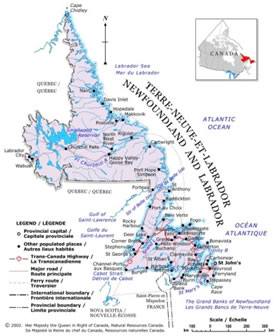 Geographically, the province consists of the island of Newfoundland and the mainland of Labrador. Capital city St John’s is home to 40% of the province’s population. According to the Newfoundland and Labrador’s Central Statistics Agency, as of March 2014, the province had a population of 526, 702; with a major chunk of it residing in St John’s. There’s quite a vivid mix of Diasporas in the region; there are people of French, Chinese, Spanish, German and Innu origin. The impact of foreign culture can be gauged from the fact that the name ‘Newfoundland’ is derived from ‘Terra Nova’ in French.
Geographically, the province consists of the island of Newfoundland and the mainland of Labrador. Capital city St John’s is home to 40% of the province’s population. According to the Newfoundland and Labrador’s Central Statistics Agency, as of March 2014, the province had a population of 526, 702; with a major chunk of it residing in St John’s. There’s quite a vivid mix of Diasporas in the region; there are people of French, Chinese, Spanish, German and Innu origin. The impact of foreign culture can be gauged from the fact that the name ‘Newfoundland’ is derived from ‘Terra Nova’ in French.
The history of this province dates back to 9000 years when the inhabitants consisted only of sea mammal hunters. Then the region had a brief contact with European explorers and subsequent conversion into an English colony. It later became a dominion and finally merged with The Canadian Federation as one of its eastern most provinces. Newfoundland and Labrador entered the Canadian Confederation only in 1949. Since then, this eastern most province of Canada has experienced lot of changes in its culture and economy; mostly due to the huge oil reserves found in the area. Just like its climate (which ranges from storms, fog, rain, sunshine and snow), Newfoundland and Labrador experienced huge variations in its economy. From a have-not province, it is now a have province.
The province’s geographical position (merger of cool Labrador Current and a warm Gulf Stream) gives it proximity to waters which are teeming with fish. As is evident from the province’s flag itself (see Figure 1), sea, snow and ice are an integral part of the life of Newfoundland and Labrador’s people. The ocean waters of surrounding Newfoundland and Labrador have been the bread and butter provider for its population for more than five centuries. Cod fishing was once the bread earner for almost every household. After the moratorium placed on cod fishing, the cod fishing industry collapsed, resulting in a severe economic slump. The ocean waters again came to the rescue of these people – it gave them crude oil, a commodity worth its price in gold. The region had major economic and development boom due to the rich energy reserves (see Figure 4). According to the Newfoundland and Labrador’s Central Statistics Agency, the goods producing sectors-fishing, mining, manufacturing etc., employ 23.2% of the 250, 000 strong work force. Several other industries also mushroomed as a result of the economic prosperity – one key example being the education sector. The low cost of living coupled with low tuition fees offered by universities, has made the province a major hub for student population.
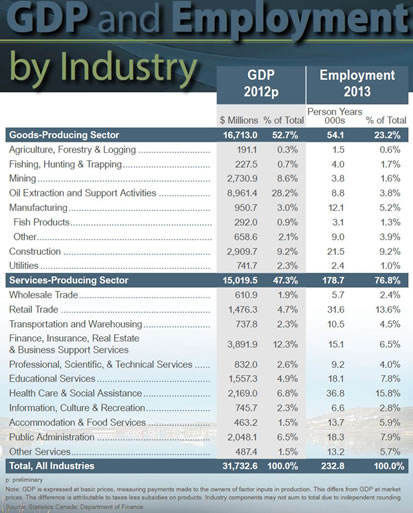
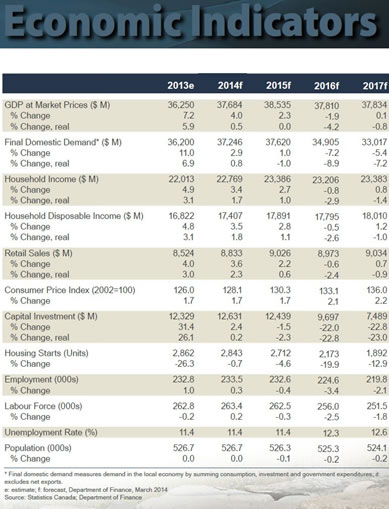
Oil and mineral reserves made the province a viable and lucrative venture for scores of companies. The growth of the mining industry had a positive domino effect on the province. Jobs were created, per capita income increased, outmigration was curbed and numerous other industries benefited from the change. Real estate, education, infrastructure, manufacturing and agriculture, all the industries developed due to the rise in provincial monetary reserves.
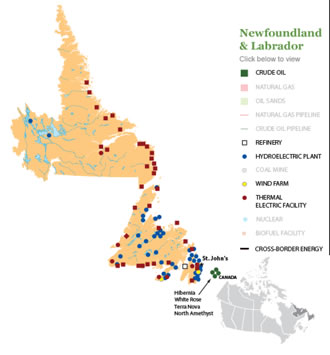 Iron ore, metals, non-metals are in abundance in the region. Gold, limestone, dolomite, slate and zinc are some of the minerals excavated here. Iron ore dominates the shipments. The province produces more than 50% of Canada’s iron ore. Another high value natural resource available here is crude oil. Three major oil fields have been operational since three decades. Today, the oil and gas industry has become the new cod industry; generating thousands of jobs for the locals and a generating a steady inflow of revenue.
Iron ore, metals, non-metals are in abundance in the region. Gold, limestone, dolomite, slate and zinc are some of the minerals excavated here. Iron ore dominates the shipments. The province produces more than 50% of Canada’s iron ore. Another high value natural resource available here is crude oil. Three major oil fields have been operational since three decades. Today, the oil and gas industry has become the new cod industry; generating thousands of jobs for the locals and a generating a steady inflow of revenue.
Economic growth in the province has surpassed that of all other provinces in 2013. According to a study published by The Leslie Harris Centre of Regional Policy and Development from 1981 to 2010 Newfoundland and Labrador’s Gross Domestic Product (GDP) per capita has increased by 550%.
But sceptics fear that this fairytale story of Newfoundland and Labrador may be approaching a not-so-happy ending. Negative natural increase, depleting oil and gas reservoirs (see figure below), environmental issues are a few areas of concern.
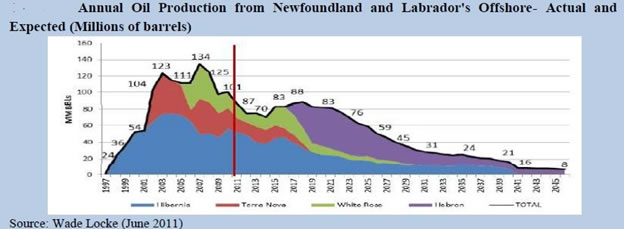
The Conference Board of Canada predicts a drop in population, a wave of out migration and a drop in provincial revenue inflow; all due to the waning of the finite & non- renewable energy resources. The Flemish Pass Basin may be a silver lining to the predicted economic dark cloud, but the production at this oil rig may not take place till 2020. For a region that has survived setbacks like the Great Depression, relinquishing independence to Canada, cod fishery collapse and progressed towards it’s ‘golden era’, with technologies like world’s fully lit marine navigation, Labrador City’s automatic railway, 17 industrial parks etc., these concerns may be just stumbling blocks to a brighter future!